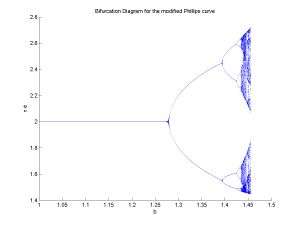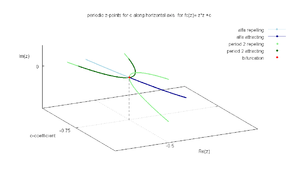Period-doubling bifurcation
In mathematics, a period doubling bifurcation in a discrete dynamical system is a bifurcation in which a slight change in a parameter value in the system's equations leads to the system switching to a new behavior with twice the period of the original system. With the doubled period, it takes twice as many iterations as before for the numerical values visited by the system to repeat themselves.
A period doubling cascade is a sequence of doublings and further doublings of the repeating period, as the parameter is adjusted further and further.
Period doubling bifurcations can also occur in continuous dynamical systems, namely when a new limit cycle emerges from an existing limit cycle, and the period of the new limit cycle is twice that of the old one.
Examples
Logistic map

Consider the following simple dynamics: where , the value of at time , lies in the interval and changes over time according to the parameter . This classic example is a simplified version of the logistic map.
For between 1 and 3, converges to the stable fixed point . Then, for between 3 and 3.44949, converges to a permanent oscillation between two values and that depend on . As grows larger, oscillations between 4 values, then 8, 16, 32, etc. appear. These period-doublings culminate at from where more complex regimes appear. As increases, there are some intervals where most starting values will converge to one or a small number of stable oscillations, such as near . See figure.
In the interval where the period is for some positive integer , not all the points actually have period . These are single points, rather than intervals. These points are said to be in unstable orbits, since nearby points do not approach the same orbit as them. See Sharkovskii's theorem.
Logistical map for a modified Phillips curve

Consider the following logistical map for a modified Phillips curve:
where :
- is the actual inflation
- is the expected inflation,
- u is the level of unemployment,
- is the money supply growth rate.
Keeping and varying , the system undergoes period doubling bifurcations, and after a point becomes chaotic, as illustrated in the bifurcation diagram on the right.
Complex quadratic map


Period-halving bifurcation

A period halving bifurcation in a dynamical system is a bifurcation in which the system switches to a new behavior with half the period of the original system. A series of period-halving bifurcations leads the system from chaos to order.
See also
References
- Kuznetsov, Yuri A. (2004). Elements of Applied Bifurcation Theory. Applied Mathematical Sciences. 112 (3rd ed.). Springer-Verlag. ISBN 0-387-21906-4. Zbl 1082.37002.